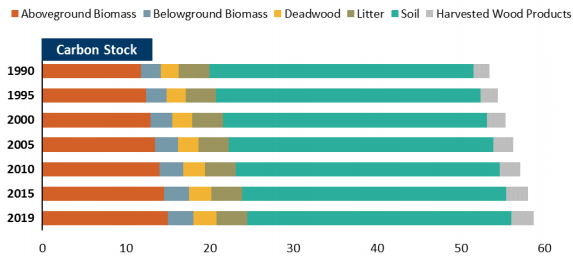Carbon Cycles and Sinks: How Forests Fight Global Climate Change
In December 2020, the Canadian government announced its plan to plant two billion trees in the next decade, at a cost of $3.16 billion. That strategy is anticipated to reduce greenhouse gas emissions by up to 12 megatons by 2050, while creating as many as 4,300 jobs in the process.
As that recent announcement reflects, forests have been increasingly recognized by policymakers around the world as a crucial component in the “carbon cycle” and the fight against climate change. Effectively managed forests can play a leading role in absorbing and storing carbon, and as such, help reduce atmospheric carbon levels associated with global warming.
What is the Carbon Cycle?
The “carbon cycle” refers to the series of processes by which carbon transitions from land and water through the atmosphere and living organisms. The National Oceanic and Atmospheric Administration refers to the carbon cycle as “nature’s way of reusing carbon atoms, which travel from the atmosphere into organisms in the Earth and then back into the atmosphere over and over again.”
Most of the carbon is stored in rocks and sediments, while the remainder resides in the ocean, atmosphere, and living organisms. While carbon travels throughout the cycle, the total amount of carbon has not changed over time.
Due to human activities such as burning fossil fuels, however, carbon balances within the cycle have shifted, with more of that carbon having been introduced into the atmosphere.
In forests, trees absorb carbon dioxide through photosynthesis. During this process, oxygen is emitted and carbon is stored in woody stems, branches, roots and leaves. The process of absorbing and depositing carbon is known as sequestration.
A forest is referred to a “carbon sink” if it absorbs more carbon from the atmosphere than it releases back into it. This outcome is positive, from a climate change perspective, with carbon stored in woody biomass, wood products, dead organic matter and soil.
On the other hand, a forest becomes a “carbon source” if it releases more carbon than it absorbs. Catastrophic disturbances such as forest fires, windstorms, and major insect infestations can increase the release of carbon and make a forest a net source of carbon in the short run.
Forest Carbon Reserves are Growing
In the past 40 years, forests have moderated climate change by absorbing approximately one-quarter of the carbon emitted by human activities such as the burning of fossil fuels and the changing of land uses. That carbon uptake reduces the rate at which carbon accumulates in the atmosphere and thus slows the pace of climate change.
In the United States, where forests cover approximately one-third of the country, forest carbon stocks have expanded by 10% since 1990. “ Overall forest carbon stocks have increased annually…, meaning U.S. forests have been a net carbon sink, absorbing more carbon out of the atmosphere than they release,” according to a 2020 report by Congressional Research Service.
As of 2019, U.S. forests stored 58.7 billion metric tons (BMT) of carbon in 2019. Most of this amount (95%) was held in forest ecosystem pools, with the remainder sequestered in harvested wood products.
Forest ecosystem carbon pools include above-ground biomass, below ground biomass, deadwood, litter, soil and harvested wood products. Forest soils are the largest pool of forest carbon, accounting for roughly 54% of storage. The second largest pool is above ground biomass, which holds around 26% of forest carbon.
The graph below shows the ongoing growth of overall carbon storage as well as the relative importance of the various forest ecosystem pools, measured in billion metric tons of carbon.

How Forest Management Helps Improve Carbon Stocks
Effective forest management helps to ensure that more carbon is sequestered and that less is released through events such as forest fires or processes such as slash burning. In the short term, management efforts are aimed at reducing carbon emissions through measures to protect against fire and insect infestations, as well as through avoiding the burning of logging slash.
In the longer term, strategies such as afforestation (planting new forests), and preventing deforestation will play critical roles. Management practices such as lengthening harvesting rotations, species selection and ensuring prompt replanting after harvest or disturbance will also play a part in promoting forest health and further building forest carbon stocks as a critical pillar in our defense against climate change.












